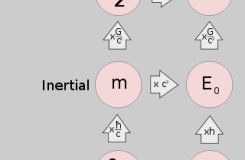 9 Terms
9 TermsHome > Terms > English, UK (UE) > Schwarzschild radius
Schwarzschild radius
The distance from the centre of an object such that, if all the mass of the object were compressed within that sphere, the escape speed from the surface would equal the speed of light. An example of an object smaller than its Schwarzschild radius is a black hole. Once a stellar remnant collapses within this radius, light cannot escape and the object is no longer visible. It is a characteristic radius associated with every quantity of mass. The Schwarzschild radius was named after the German astronomer Karl Schwarzschild who calculated this exact solution for the theory of general relativity in 1915.
In 1915, Karl Schwarzschild obtained an exact solution to Einstein's field equations for the gravitational field outside a non-rotating, spherically symmetric body (see Schwarzschild metric). Using the definition M= rac {Gm} {c^2}, the solution contained a term of the form rac {1} {2M-r}; where the value of r making this term singular has come to be known as the Schwarzschild radius. The physical significance of this singularity, and whether this singularity could ever occur in nature, was debated for many decades; a general acceptance of the possibility of a black hole did not occur until the second half of the 20th century.
The Schwarzschild radius of an object is proportional to the mass. Accordingly, the Sun has a Schwarzschild radius of approximately 3.0 km (1.9 mi) while the Earth's is only about 9.0 mm, the size of a peanut. The observable universe's mass has a Schwarzschild radius of approximately 10 billion light years.
An object whose radius is smaller than its Schwarzschild radius is called a black hole. The surface at the Schwarzschild radius acts as an event horizon in a non-rotating body (a rotating black hole operates slightly differently). Neither light nor particles can escape through this surface from the region inside, hence the name "black hole". The Schwarzschild radius of the (currently hypothesized) supermassive black hole at our Galactic centre would be approximately 13.3 million kilometres.
Assuming constant density, the Schwarzschild radius of a body is proportional to its mass, but the radius is proportional to the cube root of the volume and hence the mass. Therefore, as one accumulates matter at normal density (103 kg/m3, for example, the density of water), its Schwarzschild radius increases more quickly than its radius. At around 150 million(1.5 x 108) times the mass of the Sun, such an accumulation will fall inside its own Schwarzschild radius and thus it would be a supermassive black hole of 150 million solar masses. (Supermassive black holes up to 18 billion(1.8 x 1010) solar masses have been observed.) The supermassive black hole in the centre of our galaxy (4.5 ± 0.4 million solar masses) constitutes observationally the most convincing evidence for the existence of black holes in general. It is thought that large black holes like these don't form directly in one collapse of a cluster of stars. Instead they may start as a stellar-sized black hole and grow larger by the accretion of matter and other black holes. An empirical correlation between the size of supermassive black holes and the stellar velocity dispersion sigma of a galaxy bulge is called the M-sigma relation.
- Part of Speech: proper noun
- Synonym(s):
- Blossary:
- Industry/Domain: Science
- Category: General science
- Company:
- Product:
- Acronym-Abbreviation:
Other Languages:
Member comments
Terms in the News
Featured Terms
Electronic Entertainment Expo (E3)
Electronic Entertainment Expo, commonly known as E3, is an annual trade fair for the computer and video games industry presented by the Entertainment ...
Contributor
Featured blossaries
afw823
0
Terms
10
Blossaries
2
Followers
Top Ski Areas in the United States
 9 Terms
9 Terms
Browers Terms By Category
- Algorithms & data structures(1125)
- Cryptography(11)
Computer science(1136) Terms
- General law(5868)
- Contracts(640)
- Patent & trademark(449)
- Legal(214)
- US law(77)
- European law(75)
Law(7373) Terms
- Health insurance(1657)
- Medicare & Medicaid(969)
- Life insurance(359)
- General insurance(50)
- Commercial insurance(4)
- Travel insurance(1)
Insurance(3040) Terms
- General accounting(956)
- Auditing(714)
- Tax(314)
- Payroll(302)
- Property(1)
Accounting(2287) Terms
- Ballroom(285)
- Belly dance(108)
- Cheerleading(101)
- Choreography(79)
- Historical dance(53)
- African-American(50)



